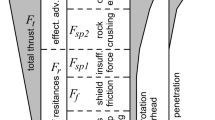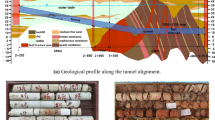Abstract
This paper presents a case study of the clogging of a slurry-shield tunnel-boring machine (TBM) experienced during tunnel operations in clay-rich argillaceous siltstones under the Ganjiang River, China. The clogging experienced during tunneling was due to special geological conditions, which had a considerably negative impact on the slurry-shield TBM tunneling performance. In this case study, the effect of clogging on the slurry-shield TBM tunneling performance (e.g., advance speed, thrust, torque, and penetration per revolution) was fully investigated. The potential for clogging during tunnel operations in argillaceous siltstone was estimated using an existing empirical classification chart. Many improvement measures have been proposed to mitigate the clogging potential of two slurry-shield TBMs during tunneling, such as the use of an optimum cutting wheel, a replacement cutting tool, improvements to the circulation flushing system and slurry properties, mixed support integrating slurry, and compressed air to support the excavation face. The mechanisms and potential causes of clogging are explained in detail, and the contributions of these mitigation measures to tunneling performance are discussed. By investigating the actual operational parameters of the slurry-shield TBMs, these mitigation measures were proven to be effective in mitigating the clogging potential of slurry-shield TBMs. This case study provides valuable information for slurry-shield TBMs involving tunneling in clay-rich sedimentary rocks.
Similar content being viewed by others
References
Feng K, He C, Fang Y, Jiang Y C. Study on the mechanical behavior of lining structure for underwater shield tunnel of high- speed railway. Advances in Structural Engineering, 2013, 16(8): 1381–1399
Huang H W, Zhang D M. Resilience analysis of shield tunnel lining under extreme surcharge: Characterization and field application. Tunnelling and Underground Space Technology, 2016, 51: 301–312
Shi C, Cao C, Lei M, Peng L, Ai H. Effects of lateral unloading on the mechanical and deformation performance of shield tunnel segment joints. Tunnelling and Underground Space Technology, 2016, 51: 175–188
Huang L C, Ma J J, Lei M F, Liu L H, Lin Y X, Zhang Z Y. Soil-water inrush induced shield tunnel lining damage and its stabilization: A case study. Tunnelling and Underground Space Technology, 2020, 97: 103290
Gong C, Ding W, Mosalam K M. Performance-based design of joint waterproofing of segmental tunnel linings using hybrid computational/experimental procedures. Tunnelling and Underground Space Technology, 2020, 96: 103172
Jin D, Yuan D, Li X, Su W. Probabilistic analysis of the disc cutter failure during TBM tunneling in hard rock. Tunnelling and Underground Space Technology, 2021, 109: 103744
Jin D, Zhang Z, Yuan D. Effect of dynamic cutterhead on face stability in EPB shield tunneling. Tunnelling and Underground Space Technology, 2021, 110: 103827
Elbaz K, Shen S L, Zhou A, Yin Z Y, Lyu H M. Prediction of disc cutter life during shield tunneling with AI via the incorporation of a genetic algorithm into a GMDH-type neural network. Engineering, 2021, 7(2): 238–251
Lei M, Lin D, Huang Q, Shi C, Huang L. Research on the construction risk control technology of shield tunnel underneath an operational railway in sand pebble formation: A case study. European Journal of Environmental and Civil Engineering, 2020, 24(10): 1558–1572
Yang J, Zhang C, Fu J, Wang S, Ou X, Xie Y. Pregrouting reinforcement of underwater karst area for shield tunneling passing through Xiangjiang River in Changsha, China. Tunnelling and Underground Space Technology, 2020, 100: 103380
Shen X, Chen X, Fu Y, Cao C, Yuan D, Li X, Xiao Y. Prediction and analysis of slurry shield TBM disc cutter wear and its application in cutter change time. Wear, 2022, 498–499: 204314
Chen T, Pang T, Zhao Y, Zhang D, Fang Q. Numerical simulation of slurry fracturing during shield tunnelling. Tunnelling and Underground Space Technology, 2018, 74: 153–166
Mooney M A, Grasmick J, Kenneally B, Fang Y. The role of slurry TBM parameters on ground deformation: field results and computational modelling. Tunnelling and Underground Space Technology, 2016, 57: 257–264
Li X, Yuan D. Creating a working space for modifying and maintaining the cutterhead of a large-diameter slurry shield: A case study of Beijing railway tunnel construction. Tunnelling and Underground Space Technology, 2018, 72: 73–83
Wu H N, Shen S L, Yang J, Zhou A. Soil-tunnel interaction modelling for shield tunnels considering shearing dislocation in longitudinal joints. Tunnelling and Underground Space Technology, 2018, 78: 168–177
Shirlaw J N, Henderson T O, Haryono I S, Dudouit F, Salisbury D. The effect of altering the slurry circulation system on TBM tunnelling in weathered Kowloon granite. Tunnelling and Underground Space Technology, 2022, 124: 104474
Li Y, Emeriault F, Kastner R, Zhang Z X. Stability analysis of large slurry shield-driven tunnel in soft clay. Tunnelling and Underground Space Technology, 2009, 24(4): 472–481
Xu C, Chen Q, Luo W, Liang L. Evaluation of permanent settlement in Hangzhou Qingchun Road crossing-river tunnel undertraffic loading. International Journal of Geomechanics, 2019, 19(2): 06018037
Wang S, Ruan L, Shen X, Dong W. Investigation of the mechanical properties of double lining structure of shield tunnel with different joint surface. Tunnelling and Underground Space Technology, 2019, 90: 404–419
Zhang L, Feng K, Gou C, He C, Liang K, Zhang H. Failure tests and bearing performance of prototype segmental linings of shield tunnel under high water pressure. Tunnelling and Underground Space Technology, 2019, 92: 103053
Min F L, Zhu W, Lin C, Guo X J. Opening the excavation chamber of the large diameter size slurry shield: A case study in Nanjing Yangtze River Tunnel in China. Tunnelling and Underground Space Technology, 2015, 46: 18–27
Zhou S, Li X, Ji C, Xiao J. Back-fill grout experimental test for discharged soils reuse of the large-diameter size slurry shield tunnel. KSCE Journal of Civil Engineering, 2017, 21(3): 725–733
Tang S H, Zhang X P, Liu Q S, Chen P, Sun XT, Sun L, Dai Y, Chen S T. Prediction and analysis of replaceable scraper wear of slurry shield TBM in dense sandy ground: A case study of Sutong GIL Yangtze River Crossing Cable Tunnel. Tunnelling and Underground Space Technology, 2020, 95: 103090
Thewes M. Adhäsion von Tonböden beim Tunnelvortrieb mit Flüssigkeitsschilden. Dissertation for the Doctoral Degree. Aachen: University of Wuppertal, 1999
Thewes M, Burger W. Clogging risks for TBM drives in clay. Tunnels & Tunnelling International, 2004, 36: 28–31
Thewes M, Burger W. Clogging of TBM drives in clay—identification and mitigation of risks. Underground Space, 2005, 1–2: 737–742
Thewes M, Budach C. Soil conditioning with foam during EPB tunnelling. Geomechanics and Tunnelling, 2010, 3(3): 256–267
Mohammadi S D, Firuzi M, Asghari Kaljahi E. Geological-geotechnical risk in the use of EPB-TBM, case study: Tabriz metro, Iran. Bulletin of Engineering Geology and the Environment, 2016, 75(4): 1571–1583
Peila D, Martinelli D, Todaro C, Luciani A. Soil conditioning in EPB shield tunnelling—An overview of laboratory tests. Geomechanics and Tunnelling, 2019, 12(5): 491–498
Yang Y, Li X, Jin D, Su W, Mao J. Transient temperature field model for a cutterhead during slurry shield tunneling. Tunnelling and Underground Space Technology, 2021, 117: 104128
Ryu Y M, Kwon Y S, Kim T H, Lee I M. Slurry clogging criteria for slurry shield tunnelling in highly permeable ground. KSCE Journal of Civil Engineering, 2019, 23(6): 2784–2793
Zhai J, Wang Q, Yuan D, Zhang W, Wang H, Xie X, Shahrour I. Clogging risk early warning for slurry shield tunneling in mixed mudstone-gravel ground: A real-time self-updating machine learning approach. Sustainability, 2022, 14(3): 1368
Li X, Yang Y, Li X, Liu H. Criteria for cutting head clogging occurrence during slurry shield tunneling. Applied Sciences, 2022, 12(3): 1001
Hollmann F S, Thewes M. Assessment method for clay clogging and disintegration of fines in mechanised tunnelling. Tunnelling and Underground Space Technology, 2013, 37: 96–106
Peila D. Soil conditioning for EPB shield tunnelling. KSCE Journal of Civil Engineering, 2014, 18(3): 831–836
Peila D, Picchio A, Martinelli D, Negro E D. Laboratory tests on soil conditioning of clayey soil. Acta Geotechnica, 2016, 11(5): 1061–1074
Alberto-Hernandez Y, Kang C, Yi Y, Bayat A. Clogging potential of tunnel boring machine (TBM): A review. International Journal of Geotechnical Engineering, 21018, 12(3): 316–323
Thewes M, Hollmann F. TBM-specific testing scheme to assess the clogging tendency of rock. Geomechanics and Tunnelling, 2014, 7(5): 520–527
Thewes M, Hollmann F. Assessment of clay soils and clay-rich rock for clogging of TBMs. Tunnelling and Underground Space Technology, 2016, 57: 122–128
Alberto-Hernandez Y, Kang C, Yi Y, Bayat A. Mechanical properties of clayey soil relevant for clogging potential. International Journal of Geotechnical Engineering, 2018, 12(6): 529–536
Kang C, Wu Y, Yi Y, Bayat A. Assessment of the clogging potential of two clays. Applied Clay Science, 2019, 178: 105134
Kang C, Yi Y, Bayat A. Laboratory test of assessing TBM clogging potential and evaluating the performance of additives. International Journal of Geotechnical Engineering, 2020, 14(5): 463–472
Kooistra A, Verhoef P, Broere W, Ngan-Tillard D, Tol A. Appraisal of stickiness of natural clays from laboratory tests. In: Proceedings of the National Symposium of Engineering Geology and Infrastructure. Netherlands: Delft, 1998, 101–113
Zimnik R, Baalen R W, Verhoef P N W, Broere W, Ngan-Tillard D J M. The adherence of clay to steel surfaces. In: Proceedings of GeoEng 2000—An International Conference on Geotechnical and Geological Engineering. Australia: Melbourne, 2000, 1–6
Sass I, Burbaum U. A method for assessing adhesion of clays to tunnelling machines. Bulletin of Engineering Geology and the Environment, 2009, 68(1): 27–34
Feinendegen M, Ziegler M, Spagnoli G, Fernndez-Steeger T. Evaluation of the clogging potential in mechanical tunnel driving with EPB-shields. In: Proceedings of the 15th European Conference on Soil Mechanics and Geotechnical Engineering: Geotechnics of Hard Soils-Weak Rocks. Greece: Athens, 2011, 1633–1638
Zumsteg R, Puzrin A M. Stickiness and adhesion of conditioned clay pastes. Tunnelling and Underground Space Technology, 2012, 31: 86–96
Zumsteg R, Plötze M, Puzrin A. Reduction of the clogging potential of clays: New chemical applications and novel quantification approaches. Geotechnique, 2013, 63(4): 276–286
Zumsteg R, Puzrin A M, Anagnostou G. Effects of slurry on stickiness of excavated clays and clogging of equipment in fluid supported excavations. Tunnelling and Underground Space Technology, 2016, 58: 197–208
Ye X, Wang S, Yang J, Xiao C, Zhou C. Soil conditioning for EPB shield tunneling in argillaceous siltstone with high content of clay minerals: Case study. International Journal of Geomechanics, 2017, 17(4): 05016002–1–8
Wang S, Liu P, Hu Q, Zhong J. Effect of dispersant on the tangential adhesion strength between clay and metal for EPB shield tunneling. Tunnelling and Underground Space Technology, 2020, 95: 103144
Cui J, Xu G, Fang Y, Chen Z, Yao Z, Tao L, Qu L. Experimental assessment of soil/metal interface adhesion behaviours of EPB shield machines. Tunnelling and Underground Space Technology, 2023, 13: 104835
Acknowledgements
The authors wish to thank the 2nd Engineering Co., Ltd. of the China Railway Tunnel Group, especially Mr. Zhaoyong Zhou and Dong Xu, whose kind help and data support for this study were invaluable. The authors gratefully acknowledge the support of funds from the National Natural Science Foundation of China (Grant Nos. 52090084 and 52208400). The insightful comments and suggestions from anonymous reviewers and editors are sincerely appreciated.
Author information
Authors and Affiliations
Corresponding author
Ethics declarations
Conflict of interest The authors declare that they have no conflict of interest.
Rights and permissions
About this article
Cite this article
Cao, C., Chen, X., Shi, C. et al. Clogging of slurry-shield tunnel-boring machine drives in sedimentary soft rock: A case study. Front. Struct. Civ. Eng. 17, 1502–1516 (2023). https://doi.org/10.1007/s11709-023-0984-8
Received:
Accepted:
Published:
Issue Date:
DOI: https://doi.org/10.1007/s11709-023-0984-8




